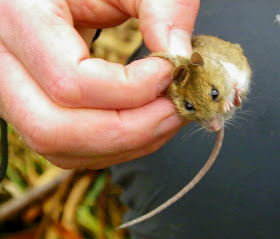 Suitable bait that will keep voles, mice and shrews all happy.
Suitable bait that will keep voles, mice and shrews all happy. Opening the Longworth trap carefully inside a bag.
Opening the Longworth trap carefully inside a bag. A bait tube for collecting droppings.
A bait tube for collecting droppings. Using the metre square to document field vole signs.
Using the metre square to document field vole signs.Spent half a day at the marvellous Field Studies Centre at Montford Bridge looking at mammal surveying methods. Simon Poulton of the National Small Mammal Monitoring Scheme showed us four ways to survey.
.The first involved using ten Longworth traps set at intervals, in our case along a hedge. He told us that we should leave the traps out a day to let the animals get used to running in and out before we set the door to close. The traps need to have a wodge of hay inside to keep the animal warm, and be baited with juicy vegetables eg a cabbage leaf or a bit of carrot to provide hydration. If you're not using one of the new Longworths with a shrew escape hole, then you must include some blowfly pupae for them to eat. You also need to download a shrew-trapping licence from Natural England and have it on you while you're using the traps. By law you must check the traps every thirteen hours.
.
Method two was to make a bait tube out of a six inch piece of plastic pipe, a square of muslin and an elastic band. Food is placed inside the tube and then it's left for seven to ten days. To check the contents - and we're talking poo here - you empty them into a plastic bag, one bag per tube, and send the droppings off for DNA analysis.
.
Method three is one I've seen botanists and geographers use: the placing of a metre square over a piece of ground and then a thorough search of the area inside. We looked for field vole signs, and found them straight away.
.
And lastly, you can go along hedgerows looking for harvest mouse nests, which are about the size of a tennis ball: http://www.flickr.com/photos/peut/499343711/
.
However, you have to be methodical about the surveying, defining the area you're working in and the length of the section you're investigating. For more details about the national monitoring scheme that's taking place right now and needs as many volunteers as it can get, check out this site: http://www.mammal.org.uk/index.php?option=com_content&view=article&id=311&Itemid=345
or this Shropshire-based one: http://www.naturalshropshire.org.uk/SpeciesGroups/ShropshireMammalGroup/tabid/54/Default.aspx

Good job Kate mate :)
ReplyDelete:-)
ReplyDeleteSee you soon!